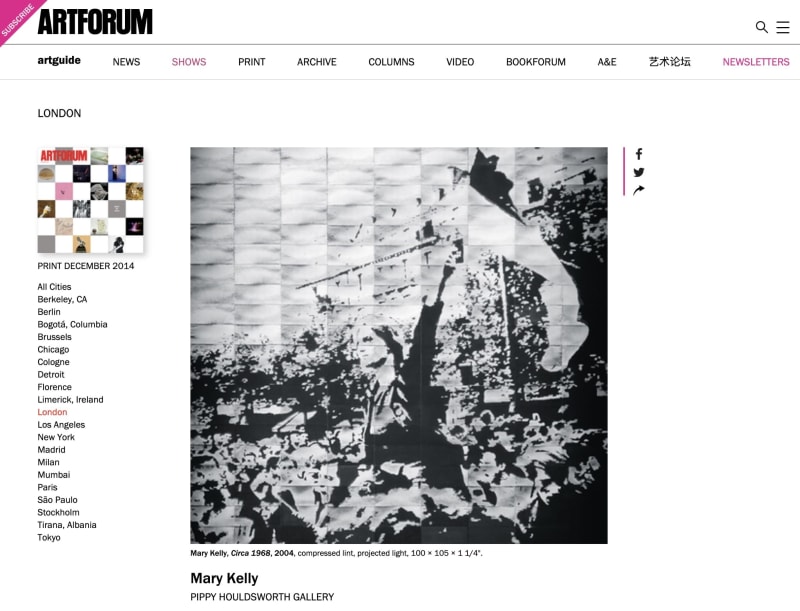PIPPY HOULDSWORTH GALLERY
One line in the 1959 Situationist film from which Mary Kelly’s exhibition “On the Passage of a Few People through a Rather Brief Period of Time” took its name hovered over the show: “When freedom is practiced in a closed circle, it fades into a dream, becomes a mere representation of itself.” Take Circa 1968, 2004, around which the show revolved: a large-scale cast that took some six months to make from the lint of roughly ten thousand pounds of laundry collected from a tumble dryer (using a process Kelly devised in 1999). The piece depicts Jean-Pierre Rey’s iconic image for Life magazine taken on the day before the May 14, 1968, strikes in Paris, showing socialite Caroline de Bendern—like a twentieth-century update of Delacroix’s Liberty Leading the People—wielding a Vietnamese flag over a charged crowd while sitting on the shoulders of artist and student occupation leader Jean-Jacques Lebel. Of course, the image is problematic: an accident in which the notably nonrevolutionary de Bendern was cast as the ultimate icon of the movement.
Projected over this was light noise—visual static that enhanced the already holographic effect of the thick and spongy lint surface, tempered by grayscale shades and textures produced in the drying cycle. The effect was spectral and set the tone for a group of new lint works (all 2014) produced for this show, which took the women’s movement in 1970s London as a starting point. (Kelly’s personal connection to this history was expressed in a lint-cast print showing her, along with other members, posed on the steps of their Alderney Street commune in 1973.) That this was a period of massive change was reflected in two 1972 covers of the short-lived, left-leaning publication 7DAYS, in which the headlines say it all. On the “Miners Special” issue, for instance, which includes the banner GERMAINE GREER TALKS, these read: MINERS ON STRIKE, STUDENTS ON THE MARCH, ONE MILLION UNEMPLOYED, and STOCKS REACH 500. Then there was the image, a black silhouette with one arm raised amid a cloud of (lint) smoke: a protester from unrecognized Rhodesia with the support of the African National Congress.
These 7DAYS covers seem undeniably familiar, especially when thinking about another large-scale work—Tahrir—that was hung opposite Circa 1968. Here, Kelly used the image of a Web screen with the URL “www.tahrir.com” as the frame for a photograph by Peter Macdiarmid of the 2011 uprisings; in Kelly’s reinterpretation, Macdiarmid’s figures become silhouettes in lint against a gold background. The result was a contrast between the clarity of Circa 1968’s image, and the burgeoning, not-quite-formed quality of that in Tahrir, suggesting that the relationship between these two “iconic” (read: historical) moments has yet to be established, or even understood. Kelly’s use of Circa 1968 as a springboard to explore what happened both before and after the uprisings of that year—the emergence of post-colonial thought, gender politics, and civil-rights movements included—is at once a starting point, an end point, and a rallying cry in an exhibition that represented not a closed cycle but an open and ongoing one.
This is especially true when considering the inclusion of a lint-cast of a Life magazine cover photograph by W. Eugene Smith from April 1945, taken one month before Germany surrendered and four months before World War II ended in Asia. The original image shows marines in combat on Iwo Jima, here reduced to lint-plumed apparitions. In this dissolution, a potent global view emerges: From 1945 to 2011, it is through lint—this ubiquitous, quotidian material—that history becomes a tumultuous cycle of images that is not so much repetitive as it is relentless, producing not only substance and residue, or memory and uncertainty, but also revolutionary potential and matter.

